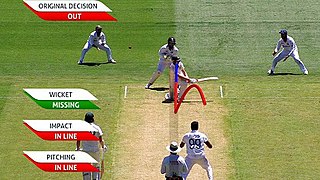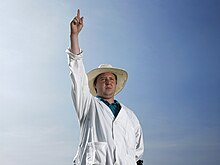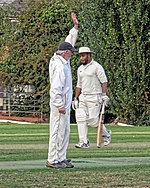
Fielding in the sport of cricket is the action of fielders in collecting the ball after it is struck by the striking batter, to limit the number of runs that the striker scores and/or to get a batter out by either catching a hit ball before it bounces, or by running out either batter before they can complete their current run. There are a number of recognised fielding positions and they can be categorised into the offside and leg side of the field. Fielding also involves trying to prevent the ball from making a boundary where four "runs" are awarded for reaching the perimeter and six for crossing it without touching the grass.

A One Day International (ODI) is a form of limited overs cricket, played between two teams with international status, in which each team faces a fixed number of overs, currently 50, with the game lasting up to 9 hours. The Cricket World Cup, generally held every four years, is played in this format. One Day International matches are also called Limited Overs Internationals (LOI), although this generic term may also refer to Twenty20 International matches. They are major matches and considered the highest standard of List A, limited-overs competition.
The Laws of Cricket is a code which specifies the rules of the game of cricket worldwide. The earliest known code was drafted in 1744 and, since 1788, it has been owned and maintained by its custodian, the Marylebone Cricket Club (MCC) in London. There are currently 42 Laws which outline all aspects of how the game is to be played. MCC has re-coded the Laws six times, the seventh and latest code being released in October 2017. The 3rd edition of the 2017 Code came into force on 1 October 2022. The first six codes prior to 2017 were all subject to interim revisions and so exist in more than one version.

The wicket-keeper in the sport of cricket is the player on the fielding side who stands behind the wicket or stumps being watchful of the batsman and ready to take a catch, stump the batsman out and run out a batsman when occasion arises. The wicket-keeper is the only member of the fielding side permitted to wear gloves and external leg guards. The role of the keeper is governed by Law 27 of the Laws of Cricket.

This is a general glossary of the terminology used in the sport of cricket. Where words in a sentence are also defined elsewhere in this article, they appear in italics. Certain aspects of cricket terminology are explained in more detail in cricket statistics and the naming of fielding positions is explained at fielding (cricket).

In cricket, a no-ball is a type of illegal delivery to a batter. It is also a type of extra, being the run awarded to the batting team as a consequence of the illegal delivery. For most cricket games, especially amateur, the definition of all forms of no-ball is from the MCC Laws of Cricket.
A doosra is a particular type of delivery by an off-spin bowler in the sport of cricket. The doosra spins in the opposite direction to an off break, and aims to confuse the batsman into playing an unavoidable shot.

In cricket, an extra is a run scored by, or awarded to, a batting team which is not credited to any individual batsman. They are the runs scored by methods other than striking the ball with the bat.

In cricket, a dismissal occurs when a batter's innings is brought to an end by the opposing team. Other terms used are the batter being out, the batting side losing a wicket, and the fielding side taking a wicket. The ball becomes dead, and the dismissed batter must leave the field of play for the rest of their team's innings, to be replaced by a team-mate. A team's innings ends if ten of the eleven team members are dismissed. Players bat in pairs so, when only one batter remains who can be not out, it is not possible for the team to bat any longer. This is known as dismissing or bowling out the batting team, who are said to be all out.
In the sport of cricket, different fielding restrictions are imposed depending on the type of match. They are used to discourage certain bowling tactics, or to encourage the batsmen to play big shots, enabling them to hit fours and sixes. Each team has nine fielders other than the wicket-keeper and bowler. The captain decides the fielding positions usually after consulting with the bowler. In Test cricket matches, the fielding restrictions are relaxed as compared to a One Day International.

The captain of a cricket team, often referred to as the skipper, is the appointed leader, having several additional roles and responsibilities over and above those of the other players. As in other sports, the captain is usually experienced and has good communication skills, and is likely to be one of the most regular members of the team, as the captain is responsible for the team selection. Before the game the captains toss for innings. During the match the captain decides the team's batting order, who will bowl each over, and where each fielder will be positioned. While the captain has the final say, decisions are often collaborative. A captain's knowledge of the complexities of cricket strategy and tactics, and shrewdness in the field, may contribute significantly to the team's success.

Caught is a method of dismissing a batsman in cricket. A batsman is out caught if the batsman hits the ball, from a legitimate delivery, with the bat, and the ball is caught by the bowler or a fielder before it hits the ground.

Run out is a method of dismissal in cricket, governed by Law 38 of the Laws of Cricket. A run out usually occurs when the batters are attempting to run between the wickets, and the fielding team succeed in getting the ball to one wicket before a batter has crossed the crease line near the wicket. The incomplete run the batters were attempting does not count.

Stephen Anthony Bucknor, OJ is a Jamaican former international cricket umpire.

A delivery or ball in cricket is a single action of bowling a cricket ball toward the batsman. Once the ball has been delivered, batsmen may attempt to score runs, with the bowler and other fielders attempting to stop this by getting the batsmen out. When the ball becomes dead, the next delivery can begin.

Aleem Dar PP is a Pakistani cricket umpire and former cricketer. He was a member of the Elite Panel of ICC Umpires. He won the David Shepherd Trophy three years in a row from 2009 to 2011, after being nominated twice in 2005 and 2006. Aleem Dar, Marais Erasmus, Richard Kettleborough, Kumar Dharmasena and Simon Taufel were the only umpires to have received the award from its inception until 2017. Before becoming an umpire, he played first-class cricket as a right-handed batsman and a leg-break bowler for Allied Bank, Gujranwala, Lahore and Pakistan Railways.

Stumped is a method of dismissing a batter in cricket, in which the wicket-keeper puts down the striker's wicket while the striker is out of their ground. It is governed by Law 39 of the Laws of Cricket.

The Second Test in the Indian cricket team's tour of Australia for the 2007–08 summer was a Test cricket match played over five days at the Sydney Cricket Ground from 2 to 6 January 2008. Australia won the match by 122 runs with minutes to spare at the end of the fifth day.

Cricket is a bat-and-ball game played between two teams of eleven players on a field at the centre of which is a 22-yard (20-metre) pitch with a wicket at each end, each comprising two bails balanced on three stumps. The batting side scores runs by striking the ball bowled at one of the wickets with the bat and then running between the wickets, while the bowling and fielding side tries to prevent this and dismiss each batter. Means of dismissal include being bowled, when the ball hits the stumps and dislodges the bails, and by the fielding side either catching the ball after it is hit by the bat, but before it hits the ground, or hitting a wicket with the ball before a batter can cross the crease in front of the wicket. When ten batters have been dismissed, the innings ends and the teams swap roles. The game is adjudicated by two umpires, aided by a third umpire and match referee in international matches. They communicate with two off-field scorers who record the match's statistical information.

The Decision Review System (DRS), formerly known as the Umpire Decision Review System(UDRS), is a technology-based system used in cricket to assist the match officials in their decision-making. On-field umpires may choose to consult with the third umpire (known as an Umpire Review), and players may request that the third umpire consider a decision of the on-field umpires (known as a Player Review).





















